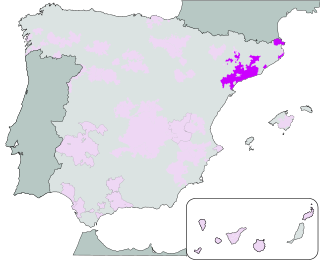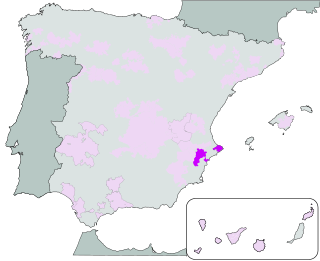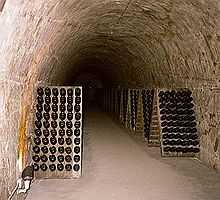
Grenache or Garnacha is one of the most widely planted red wine grape varieties in the world. It ripens late, so it needs hot, dry conditions such as those found in Spain, where the grape is believed to have originated. It is also grown in the Italian island of Sardinia, the south of France, Australia, and California's Monterey AVA, Paso Robles, Santa Barbara County and San Joaquin Valley.

Spanish wine includes red, white, and sparkling wines produced throughout the country. Located on the Iberian Peninsula, Spain has over 1.2 million hectares planted in wine grapes, making it the most widely planted wine-producing nation, but the second largest producer of wine in the world, behind Italy and ahead of France and the United States. This is due, in part, to the very low yields and wide spacing of the old vines planted on the dry soils found in some of the Spanish wine regions. The country is ninth in worldwide consumption with Spaniards drinking, on average, 21.6 litres per person a year. The country has an abundance of native grape varieties, with over 400 varieties planted throughout Spain, though 88 percent of the country's wine production is from only 20 grapes — including the reds Tempranillo, Bobal, Garnacha, and Monastrell; the whites Albariño, Airén, Verdejo, Palomino, and Macabeo; and the three Cava grapes Parellada, Xarel·lo, and Macabeo.

Cariñena is a Spanish Denominación de Origen Protegida (DOP) for wines located in Cariñena in the province of Zaragoza. It is among the oldest protected growing areas in Europe, the DO having been created in 1932 alongside other Spanish wine regions. Cariñena vineyards are located near the centre of Aragón, about 50 km southwest of Zaragoza, on the Campo de Cariñena plateau. The lower vineyards lie at an altitude of 400 m, rising to 800 m as they approach the Sierra de la Virgen mountains. To the west they border on the Calatayud (DO).

Empordà is a Spanish Denominación de Origen Protegida (DOP) for wines produced in the northeastern corner of Catalonia, Spain in the province of Girona.

Alella is a Spanish Denominación de Origen (DO) for wines produced in Maresme county in the province of Barcelona in the Spanish autonomous communities of Catalonia, located on the Mediterranean coast, 15 km to the north of the city of Barcelona.

Catalunya is a Spanish Denominación de Origen Protegida (DOP) for Catalan wine which was formally recognised in 2001. It was created with the specific purpose of providing commercial support to over 200 wineries (bodegas) that produced quality wine but which were not included in other specific DOP's in Catalonia. It does not have a specific geographical location but is formed by over 40 km2 of individual vineyards which are dispersed all over Catalonia, and allows mixing of grapes from other DOPs.

Conca de Barberà is a Spanish Denominación de Origen Protegida (DOP) for wines located in central Catalonia in the northern portion of the Tarragona Province. Situated within the river valleys of the Francolí and Anguera, it has historically been known for its white wines, but has been gaining more attention for its reds, especially those from the native Trepat grape. Today, the Conca de Barberà DOP mainly produces red wines, along with whites, and minor amounts of rosés and sparkling wines.

Costers del Segre is a Spanish Denominación de Origen Protegida (DOP) for wines located in the province of Lleida and is divided into several separate sub-zones. The four original subzones created in 1988 are Artesa, to the northeast of Lleida, Valls de Riucorb to the east, Garrigues and Raïmat. In 1998 two other subzones were added: Pallars Jussà, next to the town of Tremp, 90 km north of Lleida and Segrià to the west and surrounded by the Raimat subzone.

Priorat is a Denominació d'Origen Qualificada (DOQ) for Catalan wines produced in the Priorat county, in the province of Tarragona, in the southwest of Catalonia.

Tarragona is a Spanish Denominación de Origen Protegida (DOP) for Catalan wines, located in the province of Tarragona and covers two distinct areas: the Camp de Tarragona and the Ribera d'Ebre comarca (district).

Alicante is a Spanish Denominación de Origen Protegida (DOP) for wines located in the province of Alicante.

Utiel Requena is a Spanish Denominación de Origen Protegida (DOP) for wines located in the province of Valencia. It takes its name from the two neighbouring towns of Utiel and Requena. It is renowned for the predominant use of the Bobal grape variety.

Ribera del Guadiana is a Spanish Denominación de Origen Protegida (DOP) for wines located in the region of Extremadura (Spain). It extends over two provinces, Cáceres in the north and Badajoz in the south. It takes its name from the River Guadiana, which flows through the region from east to west.

Yecla is a Spanish Denominación de Origen Protegida (DOP) for wines located around the town of Yecla in the northernmost corner of the region of Murcia (Spain) and is surrounded by other DOPs: Jumilla to the south and west, Almansa to the north and Alicante to the east. The area is notable for its extensive use of the red Monastrell grape variety, and it is traditionally known as the home of Monastrell in Spain. Monastrell is the fourth most planted red grape variety in Spain. The international market makes up 92% of the DOP's wine sales, making it the Spanish wine DOP with the highest proportion of international exports.

Binissalem is a Spanish Denominación de Origen Protegida (DOP) for wines located around the town of Binissalem in the centre of the island of Majorca,.

Penedès is a Spanish Denominación de Origen Protegida (DOP) for wines in Catalonia, (Spain). Penedès DOP includes all of the Penedès region and municipalities of four other counties: Anoia, Alt Camp, Baix Llobregat and Tarragonès. The area is framed by the coastal hills of the Garraf Massif and the higher inland mountains which skirt the Central Depression.
Cava is a sparkling wine of denominación de origen (DO) status from Spain. It may be white (blanco) or rosé (rosado). The Macabeo, Parellada and Xarel·lo are the most popular and traditional grape varieties for producing cava. Chardonnay and Malvasia are also permitted. Authorized red grapes are Garnacha tinta, Monastrell, Trepat, and Pinot Noir. Only wines produced in the traditional method may be labelled "cava"; those produced by other processes may only be called "sparkling wines". About 95% of all cava is produced in the Penedès area in Catalonia, Spain, with the village of Sant Sadurní d'Anoia being home to many of the largest Catalan production houses. The two major producers are Codorníu and Freixenet. Cava is also produced in other villages in the provinces of Girona, Lleida, Tarragona, and Barcelona in Catalonia, Zaragoza in Aragon, Badajoz in Extremadura, La Rioja, Araba/Álava in the Basque Country, Navarra and València in the Valencian Community.

Montsant is a Spanish Denominación de Origen Protegida (DOP) for wine located in the province of Tarragona and covers 12 municipalities. It was previously known as the Falset subzone of Tarragona (DO), and was created as a separate DO in the early 2000s. Regional approval came in 2001, and from 2002 wines were sold as Montsant rather than Tarragona. Montsant takes its name from the Montsant Mountains in the area.
3 Riberas is a Spanish geographical indication for Vino de la Tierra wines located in the autonomous region of Navarre. Vino de la Tierra is one step below the mainstream Denominación de Origen indication on the Spanish wine quality ladder, and mirrors the Vins de pays of French wine. It acquired its Vino de la Tierra status in 2018.
Corpinnat is a Spanish wine designation for sparkling wines aged a minimum of 18 months made of manually-harvested organic or biodynamic grapes in Penedès. Permitted grape varieties include Macabeu, Xarel·lo, Parellada, Subirat Parent, Grenache, Monastrell, Sumoll, Rosé Xarel·lo for indigenous Spanish varieties, and small amounts of Chardonnay, Malvasia de Sitges, Pinot Noir and Trepat for foreign varieties. The appellation covers an area of 997 km2. Corpinnat means "heart of Penedès". Corpinnat was established in 2017 by six founding growers of the Cava DO intending to create a higher-quality Spanish sparkling wine.



























